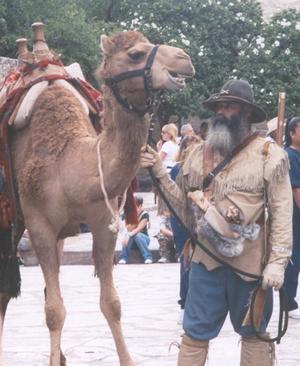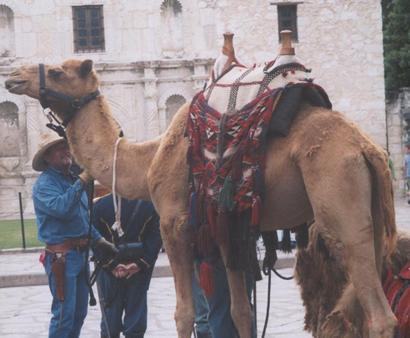|
Funny
how someone can get saddled with something another person ought to
get the credit – or blame – for.
Take Jefferson Davis, a West Point graduate from Mississippi who became
President of the Confederate States of America. Just about everyone
knows he led the South’s unsuccessful attempt at separating itself
from the rest of the Union. A lot of people also know that when Davis
served as U.S. Secretary of War in the mid-1850s, he experimented
with using camels as a means of carrying supplies for the Army.
While true enough that as a cabinet member under President James Buchanan
he signed off on what came to be called The
Camel Experiment, it wasn’t Davis’ idea.
Col.
George H. Crossman, who first proposed giving camels a try as U.S.
Army beasts of burden during the Seminole War in 1836, is the man
who should get the credit for being the committee of one who invented
the concept of using camels to carry men and freight in the American
desert. Crossman was deputy quartermaster general when he had the
idea, though it took nearly two decades to make it happen.
Like any good bureaucrat, Crossman tasked his assistant with looking
into the matter further. Maj. Henry C. Wayne set out to learn everything
he could about camels. He read up on them in Washington, and consulted
with the French minister, who had spent time in Persia and knew much
about the beasts. Satisfied that camels were indeed a good idea for
the U.S., Maj. Wayne forwarded to the Secretary of War a report suggesting
a camel program. He could make it happen, he said, for $30,000.
And he did. A shipment of 33 camels arrived at Indianola
on May 13, 1856 and the Army began using what one 19th century writer
referred to as “ships of the desert” in Texas,
New Mexico and Arizona. The camels could travel up to 50 miles a day
while carrying up to 600 pounds of supplies and equipment. They didn’t
need much water and could ingest almost any plant. |
 |
| Gil Tafolla Hernandez,
a resident of San Antonio,
is the great-great-grandson of James Tafolla who was among the army
troops that brought the camels to the interior of Texas and assisted
in their care at Camp Verde, Texas after the Civil War.
Photo courtesy Terry Jeanson, May 31, 2006 |
Texas Camel Corps
in front of the Alamo.
Recreators of the original camel journey from Indianola to Camp
Verde.
Photo courtesy Terry Jeanson, May 31, 2006 |
 |
Initial experiments
with the camels having shown promising results, the Army brought 41
more of the animals to Texas in 1857.
Though
no one could deny that camels came particularly suited for operations
in arid climes, few soldiers or teamsters felt highly of them. The
animals required difficult-to-use harnesses and other tack. Packing
camels proved a lot more difficult than loading up horses or mules.
On top of that, the unusual looking and different-smelling beasts
made the cavalry horses nervous.
“The military officers found it hard to get any hostler to attend
to the camels, towards which all the cavalrymen and troopers took
a violent dislike,” the San Francisco Chronicle reported in 1895 in
an article reprinted in Texas.
Just
as Crossman and Wayne’s role in the Army’s camel unsuccessful experiment
is not well known, a private sector attempt to put camels to good
use in Texas never got much ink, either.
A British ship carried two loads of camels to Galveston
in 1858 for private use. After being offloaded, the animals were transported
to the Watson Ranch, near Houston.
While the camels earned their keep as pack animals, the ranch owner
eventually gave up on the idea because they caused too much commotion
when someone from the ranch took them into Houston.
“In the last year or two of their stay at [military garrisons including
Camp
Verde in Kerr County] they were merely pensioners upon Uncle Sam’s
bounty, and were never brought into service,” the Chronicle said.
The outbreak of the Civil War ended any military interest in camels.
When federal forces abandoned Texas,
the camels stayed behind left to fend for themselves.
“The beasts were allowed to wander away at will,” the San Francisco
newspaper said. “They traveled in pairs, and sometimes in bunches
of four and six, across the deserts and into the mountains….In some
instances the camels multiplied, but in twenty years most of them
died…or were killed by Indians.”
However, some of the animals proved they could cling to life as tenaciously
as their systems could conserve water.
“Many a passenger on the Southern Pacific railroad trains has had
a sight of some gaunt, bony and decrepit old camel away off in the
distance,” the newspaper article related.
By the mid-1890s, nearly four decades after their introduction to
Texas and the Southwest, the camels had
just about died out.
© Mike Cox
"Texas Tales"
September 12, 2007 column |
| Books
by Mike Cox - Order Here |
|
|
